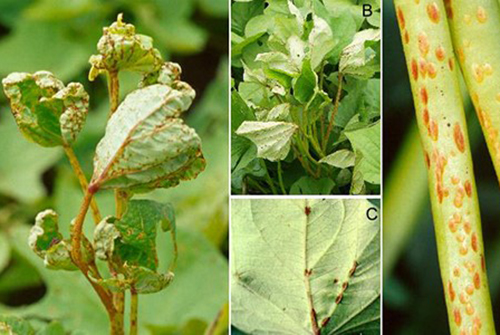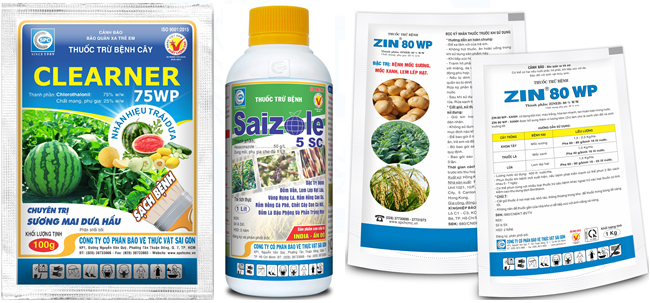|
Scabies Prevention On Sweet Potatoes
10/11/2021
BSc Kim Xuan Loc Pathogens: Scabies on sweet potatoes is caused by the Sphaceloma batatas Sawada fungus. Symptoms and effects: - Fungal diseases appear and cause damage mainly on stems, petioles and leaves. - On stems and petioles: The lesions are grayish-white at first, then turn light brown, the size of the lesions is small, round or long oval, later the surface of the lesion is rough, gray-brown or dark brown. Lesions may join together to form streaks or clusters on stems and petioles. - On leaves: Lesions are often clustered in small clusters , small brown color on the main veins.. When the disease develops strongly, the leaf veins shrink, causing the entire leaf to shrink and curl. - The disease usually arises first and most often in the young parts of the plant, making this part deform, greatly affecting the growth and development of the vines of potatoes , making the potatoes tubers small and few. - Scabies on sweet potatoes is a dangerous disease, if the potato field is seriously diseased, it can reduce the yield by up to 50%. Conditions of development: - The spread of fungal diseases in the field depends on many factors, but mainly through rubbing wounds, through rain, through insects and the use of infected potato vines as seed. - High air temperature and humidity are suitable conditions for fungal disease to spread and grow. - Sweet potatoes grown in low lying soil, loammy soils often suffer more severe diseases than other ones. - The disease can cause damage at all growth stages of potatoes, but often cause severe damage in the period from when potatoes start planting tubers to harvest. Preventive measures: - Use disease-free seed sources (vines and tubers). - Rotating with different family crops. - Select disease-resistant varieties to limit disease development. - Collect and destroy the stems , leaves and vines of the sweet potato after harvesting. - Planting beds in high raise - Treat cuttings or tubers before planting or cutting by dipping in Zin 80WP solution, concentration of 1/600 for 15 minutes. - During the planting process, when the first symptoms are detected in the field, we can use special treatment products such as SAIZOLE 5SC, CLEARNER 75WP, DIPOMATE 430SC, SULOX 80WP ... spray to prevent fungal diseases. If the disease pressure is severe, we spray the second time, 5 days apart. |
To prevent, in addition to plowing and burying weed seeds, collecting weed stalks and stumps left after tilling the land to burn, not letting weeds produce seeds in production fields, etc., the use of chemical products is still a measure. optimal because of its ability to thoroughly kill weeds, reduce labor and take advantage of more time than manual weeding.
Miner has the scientific name Phyllocnistis citrella Staint., family Phyllocnistidae, order Lepidoptera. The miner occurs in many countries in the tropics and subtropics. The main host of the miner is the citrus family - Rutaceae. In addition, the miner also attacks mangosteen and some other plants.
Adult is a small planthopper, with a body 2-3 mm long, the whole body is ash gray, slightly greenish, the wings are opaque with many small brown spots.Eggs are oval, 0.3 mm long, have a pointed end and are attached directly to the leaf surface, leaf axils.
Green bugs specialize in the fruit of citrus groups (oranges, tangerines, lemons, grapefruits, kumquats...), some people call them orange bugs, or orange suckers. Their scientific name is Rhynchocoris poseidon or Rhynchocoris humeralis.
In Vietnam, yellow leaf curl disease is very common on papaya trees, especially the disease is often severe in areas of high and continuous planting, areas with hot and arid climates. The disease has significantly reduced the yield and quality of papaya. Gardens that are infected early when the plants are young may not yield. However, up to now, many gardeners still do not know the cause and how to fix it.
Spider mites are common pests on citrus trees, especially in hot and dry climates that are suitable for spiders to grow and cause severe damage.The group of harmful spiders is usually very small in size, unlike the natural enemy spiders.
This group includes species that are generally very small in size, causing damage by sucking plant sap (on leaves, fruits, branches, stems).
There are many species of mealybugs present on the group of Oranges,Tangerines,Grapefruits and Lemons (Citrus), which can be divided into 2 groups:
+ Group of sticky mealybugs with common varieties such as Lepidosaphes, Aonidiella, Coccus and Saissetia.
+ Group of flower mealybugs with common genera and species such as Pseudococcus, Planococcus and Icerya purchasi.
Dry branches and berries disease often appear to be common damage on coffee gardens during the rainy season. The disease causes death of branchs, dry fruit, severely affects the canopy structure and coffee yield if not paid attention to prevention.
Pink disease commonly causes diseases on rubber plantations in the rainy season, especially on garden from 4-8 years old. This year, rubber has to go through a period of severe drought, weakening the tree, so now in tnshe rainy season it is easy to get infected. Therefore, it is necessary to pay attention to good management to avoid affecting the garden.
In recent years, the area of citrus has been expanded because it is a fruit tree with high economic efficiency. However, in order to sell at a high price, not only in quality but consumers also require the external beauty of the fruit, so pest management on citrus is a matter of great concern to farmers. The hot season is a favorable condition for thrips to develop and cause damage, affecting the commercial value of fruit.
- Headquarters
- SAIGON PLANT PROTECTION JOINT STOCK COMPANY
- RQ 1, Nguyen Van Quy St., Tan Thuan Ward, HCM City
- Tax code: 0300632232
- Tel: (028) 38 733 295 - 38 732 077
- Fax: (028) 38 733 003 - 38 733 391
- Website: www.spchcmc.vn - Email: info@spchcmc.vn
- SAIGON PLANT PROTECTION COMPANY
- SAIGON PLANT PROTECTION JOINT STOCK ENTERPRISE
- Lot C1-C3 Hiep Phuoc Industrial Park, Hiep Phuoc Commune, HCM City
- Tel: (028) 3873 4089 - Fax: (028) 3873 4086
- Affiliated Unit
-
- Quick Links
- Home
- About us
- Career Opportunities













